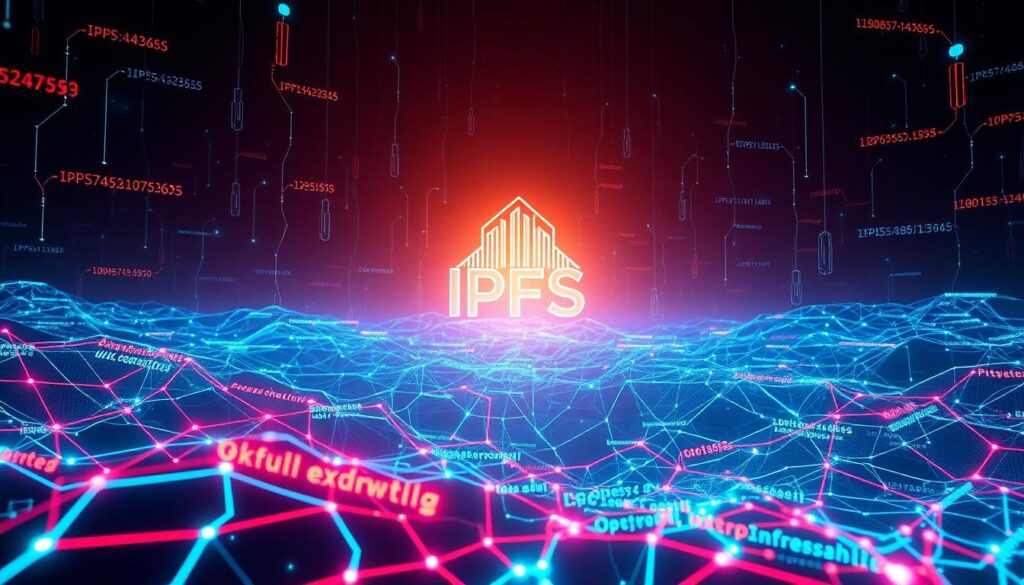Now Reading: NFT Metadata Storage IPFS System: Decentralised Solution
- 01
NFT Metadata Storage IPFS System: Decentralised Solution
NFT Metadata Storage IPFS System: Decentralised Solution

Digital collectibles have transformed how we think about ownership in the online world. These unique tokens represent more than just digital art—they embody a new way of managing digital assets. This comprehensive guide explores the decentralised approach to preserving these valuable items.
Traditional centralised servers present significant risks for long-term preservation. When servers go offline or companies shut down, valuable digital information can disappear forever. The decentralised model offers a more resilient alternative that protects against these vulnerabilities.
The InterPlanetary File System provides a content-addressed network that ensures permanent accessibility. This technology creates distributed networks with immutable links, keeping associated media files secure and tamper-proof over extended periods.
Understanding where digital collectible information actually resides is crucial for creators and collectors alike. Many people mistakenly believe all data lives directly on the blockchain, when in reality, most media files require separate storage solutions.
This guide will walk you through practical implementation strategies for your projects. You’ll learn about linking techniques and persistence mechanisms that safeguard your digital assets from potential data loss scenarios.
Key Takeaways
- Decentralised storage provides permanent preservation of digital assets
- Content addressing ensures files remain accessible over time
- Distributed networks offer greater resilience than centralised servers
- Understanding on-chain versus off-chain storage is essential
- Proper linking strategies protect against data loss
- Immutable connections maintain asset integrity
- Best practices ensure long-term value for digital collectibles
Introduction to IPFS and Decentralised Storage for NFTs
Modern technology requires robust solutions for safeguarding digital creations. The InterPlanetary File System represents a groundbreaking approach to preserving valuable digital assets through community-driven networks.
What is IPFS and How Does It Work?
This innovative system functions as a global library where each participant contributes storage space. Instead of locating files by their server address, the network identifies content through unique digital fingerprints.
The technology employs four core components that ensure reliable operation. Content addressing creates permanent identifiers, while directed graphs organise information efficiently across the distributed network.
Why Decentralised Storage Matters for NFT Data
Traditional centralised servers present significant vulnerability risks. When companies shut down or servers fail, valuable digital assets can disappear permanently.
Distributed networks offer superior protection against single points of failure. Recent studies show these systems reduce data loss risks by over 90% compared to centralised alternatives.
| Feature | Centralised Storage | Decentralised Network |
|---|---|---|
| Data Accessibility | Dependent on single server | Distributed across multiple nodes |
| Failure Resistance | High risk of complete loss | Continuous access even if nodes fail |
| Long-term Preservation | Limited by company lifespan | Community-maintained permanence |
A common misunderstanding involves where digital asset information actually resides. Most projects store only token identifiers on-chain, while associated content remains in separate storage solutions.
This approach ensures that collectibles maintain accessibility regardless of individual node availability or provider changes. The distributed nature creates redundancy similar to keeping backup copies with trusted friends.
NFT metadata storage IPFS system: Best Practices
Creating successful digital collectibles demands meticulous preparation of their descriptive information. Proper organisation from the start ensures your tokens display correctly across various platforms and retain their long-term value.
Preparing and Organising Your NFT Metadata
Most tokens require structured data to define their properties. The common standard is a JSON object, which acts like a digital ID card for your asset.
Following established schemas, such as those in ERC-721, guarantees compatibility. This ensures wallets and marketplaces can read and display your collection without issues.

A typical JSON structure includes essential fields. These describe the token’s core identity and characteristics.
| Field | Purpose | Example Value |
|---|---|---|
| name | Defines the token’s title | “Galactic Explorer #1” |
| description | Provides a detailed overview | “A unique digital astronaut.” |
| image | Links to the visual asset | “ipfs://QmXyZ…” |
| attributes | Lists unique properties | Background: “Space” |
Linking Smart Contracts with Decentralised Content
The sequence of operations is critical for a successful launch. Always upload your media files first to obtain their unique Content Identifier (CID).
Once you have the CID, you can construct your JSON data. This data references the asset using a tamper-proof IPFS URI instead of a standard web link.
This method creates a permanent link between your on-chain contract and the off-chain content. It removes reliance on any single server, preserving the asset’s integrity.
For better organisation, wrap files in a directory when adding them. This preserves human-readable filenames within the resulting URI, making management simpler.
Understanding IPFS Links and Identifiers
Three distinct link types provide different pathways to access distributed content. Each serves specific purposes in managing digital assets effectively.

CID, IPFS URI and HTTP Gateway Explained
Content Identifiers (CID) act as unique fingerprints for your data. These random-looking strings ensure permanent identification regardless of location.
Two CID versions exist with important differences. Version 1 identifiers use base32 encoding for better gateway compatibility.
| CID Version | Starting Characters | Recommended Use |
|---|---|---|
| Version 0 | Always begins with “Qm” | Legacy systems |
| Version 1 | Variable starting characters | New projects |
The IPFS URI format adds “ipfs://” before your CID. This creates unambiguous references that clearly point to distributed content.
HTTP gateway URLs bridge traditional web browsers with distributed networks. They follow patterns like https://gateway.example/ipfs/[CID] for easy access.
Utilising Different Link Types for Various Use Cases
Choose your link type based on specific requirements. Each format serves different audiences and applications.
- Use IPFS URI for on-chain references
- Employ gateway URLs for user-facing applications
- Utilise raw CID for internal management
Remember that gateway links depend on third-party services. While convenient, they shouldn’t replace IPFS URI as primary references.
This approach ensures your content remains accessible through multiple pathways. It balances user convenience with long-term preservation.
Technical Considerations for NFT Data on IPFS
Developers working with distributed networks must consider how file organisation affects both management and user experience. Proper structuring of digital asset information ensures collections remain manageable as they scale in size and complexity.
Managing File Structures with IPFS Directories
Wrapping files within directories preserves human-readable filenames instead of exposing only cryptographic hashes. This approach creates cleaner, more understandable URIs that benefit both developers and end users.
In JavaScript implementations, developers can use the wrapWithDirectory option when calling ipfs.add methods. When this option is enabled, the system returns the Content Identifier of the directory object rather than individual file identifiers.
To construct a complete URI for a specific file within a wrapped directory, append a forward slash followed by the filename to the directory CID. This creates references like ipfs://[directory-CID]/metadata.json that maintain both content addressing and meaningful naming conventions.
The underlying technology uses Directed Acyclic Graphs to organise information efficiently. This tree-like structure allows each piece of content to link to related elements without circular references, enabling rapid location and retrieval of digital asset components.
Planning file structures before upload helps determine whether individual file CIDs or directory-level organisation better serves specific platform requirements. This foresight prevents organisational challenges when managing collections with multiple assets per token.
Ensuring Data Persistence and Network Availability
Maintaining permanent access to digital assets requires strategic planning beyond initial upload. The distributed nature of content addressing introduces unique challenges for long-term preservation that demand careful consideration.

Implementing Effective Pinning Strategies
When content is added to the distributed network, users can retrieve it from any participating nodes that hold a copy. This efficient system reduces strain on individual servers while improving overall availability.
However, these cached copies are temporary by design. Pinning represents the crucial mechanism for marking specific content as permanently retained. This practice instructs nodes to preserve important data even when storage space becomes limited.
Platforms handling valuable digital items must implement robust pinning strategies. Options include maintaining private ipfs infrastructure or using specialised remote pinning services like Pinata and Eternum.
Services such as NFT.storage offer free solutions specifically designed for public digital collectibles. These provider options ensure long-term persistence without vendor lock-in risks.
Proper data persistence planning should be integrated into initial platform design. This foresight prevents accessibility issues that could compromise digital asset value and user trust.
Optimising NFT Metadata Storage for Long-Term Value
Building resilient digital collectibles requires thoughtful integration between blockchain technology and decentralised storage solutions. This approach ensures your digital assets remain accessible and valuable for years to come.
Integrating Decentralised Solutions with Blockchain
Smart contracts should reference digital content using the canonical ipfs:// URI scheme. This creates clear, permanent links between your token and its associated media.
Applications can generate HTTP gateway URLs for users whose browsers lack native support. Providing both link types maximises accessibility while promoting decentralised protocols.

Within the descriptive information itself, always use ipfs:// URIs when linking to images and other media. The Content Identifier system guarantees data integrity while the scheme provides unambiguous retrieval instructions.
| Integration Aspect | Recommended Approach | User Benefit |
|---|---|---|
| Smart Contract Reference | Use ipfs:// URI as primary link | Permanent, vendor-independent access |
| Application Display | Show both URI and gateway URL | Maximum compatibility across devices |
| Internal Media Links | Employ ipfs:// scheme exclusively | Clear data retrieval path |
Leveraging Multiple IPFS Providers and Tools
Developers can choose from various service providers based on project needs. Free options like NFT.Storage work well for smaller collections, while commercial services suit larger projects.
Some platforms handle the entire upload and pinning process automatically. This simplifies the workflow for creators focusing on their artistic vision.
Using multiple providers creates valuable redundancy. The content-addressed nature allows seamless migration between services as your platform scales.
This strategy avoids vendor lock-in while ensuring your digital assets remain persistently available. Proper planning at the design stage prevents future accessibility issues.
Conclusion
Adopting a decentralised approach fundamentally secures the future of digital collectibles. This guide has outlined how a robust framework protects valuable assets from the fragility of centralised servers.
The core principles are clear. Always use the canonical ipfs:// URI as the primary link within smart contracts and descriptive data. For broader accessibility, applications should generate HTTP gateway URLs for users. Wrapping files in directories preserves meaningful filenames.
Most importantly, long-term persistence must be a primary design consideration for any platform. Implementing reliable pinning strategies, whether through dedicated infrastructure or services, ensures token content remains permanently accessible.
By following these practices, developers and creators build trust and protect investments. This foundation supports not just static images but also the evolving applications of this technology, guaranteeing a healthy lifespan for digital cultural artefacts.
FAQ
What is the main advantage of using IPFS for tokenised assets?
The primary benefit is decentralisation. Unlike traditional web servers, a piece of content on the InterPlanetary File System is distributed across a global network of computers. This enhances resilience and ensures the information remains accessible even if a single platform or server goes offline.
How do I ensure my digital collectible’s images and details stay online permanently?
Achieving long-term availability requires a robust pinning strategy. This involves using services from providers like Pinata or Infura to ‘pin’ your data, meaning they guarantee its persistence on their nodes. Relying solely on your own machine or casual sharing is not sufficient for valuable assets.
What is a CID and how is it used in a smart contract?
A Content Identifier (CID) is a unique fingerprint for your data on the IPFS network. It is derived from the content itself. When you mint a token, this CID is typically stored within the contract’s code, often as part of a URI, creating an unchangeable link between the blockchain token and its associated media.
Can users view my token’s media without special software?
Yes, through public HTTP gateways. Services like those from Cloudflare or the official ipfs.io gateway allow anyone to access content using a standard web browser. For instance, adding `https://ipfs.io/ipfs/` before your CID creates a web-friendly link, though this relies on the gateway’s own uptime.
Should I store each asset individually or as part of a collection directory?
For a series of related items, using an IPFS directory is often more organised. You can upload a folder containing all your assets, which receives its own CID. Each file within the directory then has a predictable path, simplifying the management of your project’s file structure and links.
What tools can developers use to integrate this system?
Several libraries and command-line tools are available. Popular choices include the JS-IPFS library for web applications and the go-ipfs client for backend services. These tools help with adding content, generating CIDs, and managing connections to the peer-to-peer network efficiently.














